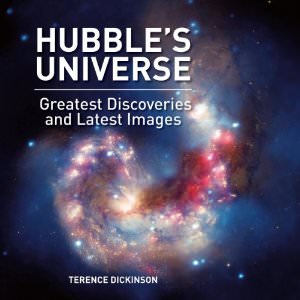The Hubble Space Telescope has been the subject of several books and articles, and certainly much more will be written about it in the future, as its status as the world’s most successful science experiment will guarantee that. And though breathtaking images are what hooks many people on the telescope, the Hubble was designed and built to do more than just take pretty pictures. The Hubble was planned and built to shed light on several different issues in astronomy and cosmology.
A new book, “Hubble’s Universe: Greatest Discoveries and Latest Images,” by Terence Dickinson, explains the important contributions Hubble has made in the areas of galactic evolution, dark matter and dark energy, and the expansion rate of the Universe. After a quick recounting of the Hubble’s launch and its well-documented initial problems, the author spells out Hubble’s top discoveries, including Hubble’s contribution to our understanding of the super-massive black holes at the centre of galaxies and our first looks at the atmospheres of extra-solar planets.
But the book is more than just clear and readable explanations of discoveries in astronomy. It’s a stunning picture book, equally at home in the living room as it is in the study. The array of pictures is simply awesome, and as Universe Today readers know, astronomy photos can suck anyone in.
See a gallery of new images from the book here.
Find out how you can win a copy of this book here.
The Hubble Space Telescope and the people that work with it are responsible for the images in this book, but it takes a special person to put a book like this together. The author, Terence Dickinson, is well-known in astronomy circles. If you don’t know who he is, you should. He’s the author of the top-selling star-gazing guide in the world, “NightWatch: A Practical Guide to Viewing the Universe,” as well as 14 other books. He’s won numerous awards for science-writing and for the popularization of science. An accomplished astro-photographer, one of his photos of the Moon has been on a U.S. postage stamp. He’s even been awarded the Order of Canada, the country’s second highest honour for merit. Terence Dickinson has a healthy passion for science, and has spent his life igniting that passion in others.
“Hubble’s Universe” is loaded with hundreds of photos of the kind we’ve become used to from Hubble, and some in the book have never before been published (see some of them here). The beauty of glowing gas clouds, the rich luminescence of filaments of gas and dust in distant nebulae, the beauty of the planets in our own solar system. This book is basically a feast of astrophotography.
While many books have been written about Hubble, this one will stack up against any of them. All Hubble books have stunning images in them, but what makes this one special is Dickinson’s ability for explanation. The writing is very accessible while still doing an outstanding job of handling some difficult subjects. If you’ve ever struggled with explanations of things like Dark Matter and Dark Energy, “Hubble’s Universe” will bring clarity, without any dumbing down of the subject matter.
You won’t regret buying this book, for yourself or perhaps for someone else. It’s destined to be a staple in libraries and astronomy collections. I’ll be bold and go a little further. “Hubble’s Universe” is destined to be a classic much like some of Dickinson’s other books.
Here’s a video of Dickinson discussing Hubble and his new book:


the Hubble has been a historical area of inspiration to the world astronomical discoveries
Hello Evan and Mrs. Gough (I’m on the left coast too). I only wish our weather could be more amenable for night sky viewing, although I have lived in remote communities where light pollution is minimal. Yet, for all the visible stars, the Hubble orbital telescope never ceases to amaze with images of deep and deeper space. It stretched our current understanding of the age of the Universe, provided unforgettable photos of Nebulae, and lest we forget its’ namesake(?), Dr. Hubble expanded horizons by demonstrating that some of those smudges in the Milky Way were actually distant galaxies, which are now without number. Sagan’s billions have become trillions (or gazillions). Infinite realm; imagination with no scope. I’ll look for Dickinson”s books. Thanks.